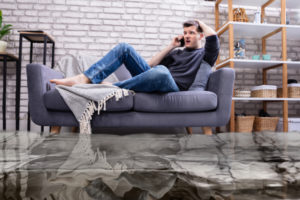RECOVERING FROM WATER DAMAGE
Water can have devastating effects on your home’s structural integrity. It can even lead to indoor air quality problems if mold starts to grow. Here’s how to tell if you need water damage restoration and what that process looks like.
Signs of Water Damage
Regularly inspect your home for these signs of excess water:
- Musty odors and mold growth: Mold thrives in moist environments. Even if it’s not visible, you should be wary of lingering musty smells anywhere in your home.
- Standing water: A broken pipe, a leaky roof, or a flooded basement can cause water to pool inside. If you find standing water anywhere, clean it up and fix the source of the leak. If the damage is extensive, you may need remediation services.
- Ceiling and wall stains: Water rings on the upstairs ceiling could indicate a roof leak. Then, stains on the ceiling or wall of your home’s lower floors could mean an appliance or plumbing fixture directly above it is leaking.
- Squishy floors, ceilings, or walls: Water damage is not always visible. In fact, it commonly occurs behind finished surfaces where you can’t see it. Feel around for soft spots on the floors, ceilings, and walls. This indicates that joists, rafters, and studs are rotting and mold is almost certainly present.
- Foundation damage: Routine foundation inspections can help you find and fix water damage before substantial repairs become necessary.
Steps in the Water Damage Restoration Process
If you suspect water damage, don’t delay the repair process! The sooner you act, the faster you can recover your home to its pre-flood condition. Here’s how water damage repair works:
- Water removal: The first step is to eliminate all standing water. If a high water level results from excessive flooding, the water is pumped out using a truck-mounted or portable extraction unit.
- Drying: Industrial dehumidifiers, high-speed air movers, and other tools evaporate water from saturated materials as quickly as possible. The cleanup crew uses moisture detectors, hygrometers, and thermal imaging cameras to pinpoint less obvious saturation to ensure thorough drying. Depending on the extent of the damage, this could take a few days to complete.
- Cleaning, sanitation, and odor removal: Building materials and personal belongings may have an unpleasant musty smell even after the water has been removed. Deodorizing and disinfecting eliminates odors and prevents mold growth. Be aware that some extensively damaged materials such as drywall, flooring, and ceiling tiles may need to be replaced during cleanup.
- Mold removal: Unless the drying process is fully completed within 24 to 48 hours, mold may grow on wet materials. This may require you to request mold remediation in addition to water removal.
Indoor Green Solutions offers professional water damage restoration in Maryland, Virginia, and Washington, DC. We have over a decade of experience with water and mold removal, and we guarantee your 100% satisfaction.
Call us today to request a free water damage restoration estimate in the DC area.

